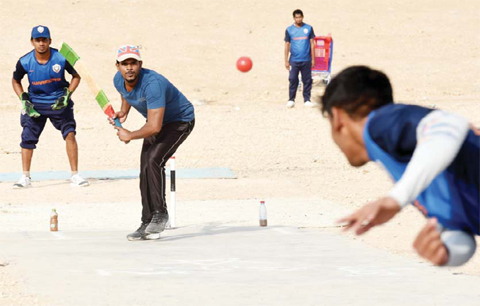 RIYADH: Even the best groundkeeper’s skills would be lost on this grassless pitch in the Saudi capital Riyadh where Asian expats make the most of an improvised version of cricket. “This ground is full of stones and everything,” said Kiran Ravi, 26, from India, blaming the sandy lot beside a shopping mall’s parking lot for his team’s slow run buildup on the first day of a tournament. There are no carefully manicured grass pitches for cricketers in this city carved out of the desert.
RIYADH: Even the best groundkeeper’s skills would be lost on this grassless pitch in the Saudi capital Riyadh where Asian expats make the most of an improvised version of cricket. “This ground is full of stones and everything,” said Kiran Ravi, 26, from India, blaming the sandy lot beside a shopping mall’s parking lot for his team’s slow run buildup on the first day of a tournament. There are no carefully manicured grass pitches for cricketers in this city carved out of the desert.
In Riyadh, there is hardly any grass at all. The players make do with what they have: lots of asphalt or, in this case, the dangerous rock-strewn sand beside Granada Mall and the multi-lane roads that surround it. Millions of expatriate workers from cricket-mad South Asia work in Saudi Arabia.
For the talented players among them, Ravi’s Warriors and other teams offer a chance to relax, even without a normal pitch. “You don’t find anything like entertainment” in the ultra-conservative Islamic kingdom, said team-mate Vasant Warrier, 36. He was seated on the back of a pickup truck, marking off the runs for his team on a scoresheet. “We play cards. We play cricket. Sometimes we play football.” For Fazeel Mihar, 27, who belongs to a team of Sri Lankans, the Rising Stars, cricket is a chance to “release the tension”. Mihar, who played under-19 cricket in his homeland, works as a household driver and would be back on the job after Friday’s match, toiling until the wee hours of Saturday. Other players work in everything from juice production to sales and logistics. Friday, the Muslim weekend, is their day off-and their match day.
The 10-over contest between the Warriors and Rising Stars was well under way by 7:00 am before the worst of Riyadh’s 40 Centigrade (104 Fahrenheit) heat bore down them. A second tournament match was being held at the same time on a neighbouring rough ground outside the mall’s Debenhams department store. A total of 16 teams, with mostly Indians and Pakistanis, were in competition for prize money of 1,200 riyals ($320), which each team contributed to and will go towards their equipment. While the ground may not impress, the Warriors’ uniforms do. A stylised lion adorns the blue caps which they paid for themselves. Matching jerseys bear each man’s name.
CRICKET’S ‘REAL SPIRIT’
Players ask visiting family and friends to bring bats from India because those available locally are not of the best quality. The ball, normally used for tennis, looks authentic enough after it is bound in red tape. “It will give speed and swing,” Ravi said, explaining that a conventional stitched cricket ball can’t be used on the hard Riyadh surfaces. The wicket itself is an uneven-edged strip of concrete, with mats laid down on the rough ground around the stumps. There can be no dramatic diving catches on this surface where the fielders, their faces beaded in sweat, throw up puffs of dust as they run. “Here in Saudi Arabia we lack grounds,” said Ravi, a player since his high school days in the Saudi capital. In neighbouring Qatar, where South Asian labourers make up a much higher proportion of the population, cricketers have it better.
Their Asian Town stadium is a green oasis that seats 14,000. Warrier, a 14-year veteran of Riyadh cricket, said the city’s burgeoning construction projects have eaten away at space for the game. In any case, Saudis prefer football. India and Pakistan, major contributors to the Saudi workforce, are fierce opponents both in politics and international cricket. Such rivalries are put aside on the predominantly- Indian Warriors side, which includes some Pakistanis in what Ravi calls “the real spirit of cricket.” On match day, the Warriors were all out for 79, sending the raucous Rising Stars in to bat. Mohammed Halfees, 27, who had taken four wickets, rested his scoresheet on a bat to record the fours and sixes that quickly pushed the Stars to a six-wicket victory on the stony ground. —AFP










